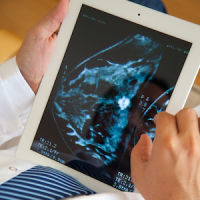The use of artificial intelligence (AI) continues to grow in healthcare, such as in enhancing the performance and accuracy of diagnostic tools and disease risk prediction algorithms. And while radiology is among the medical specialities most primed to incorporate AI into clinician workflow, it appears that many radiologists are not even sure exactly what that means, says Dr. Allison Grayev, of the Department of Radiology, University of Wisconsin School of Medicine and Public Health.
Such "disconnection", the doctor points out, can lead "us to have a negative view of the future of technology-enhanced radiology, which can then discourage medical students from entering the field."
You may also like: Breast imaging e-learning courses help radiographers
In an article to appear in the journal Academic Radiology, Dr. Grayev highlights the need for radiologists to be more informed about AI and tech innovations, as this will enable them to utilise these advanced techniques to their advantage. Importantly, with this technical know-how, radiologists can help to educate medical students about the exciting potential for AI applications in the future.
"Students rely on us to understand how radiology is incorporating new technology and what the future of the field will look like for them, but many of us are ill prepared to teach the younger generation about this, mostly because we ourselves are not sure," the author says.
To better understand the future, according to the author, it is important to look to the past to understand the ways that we have already incorporated AI. "Remember the days of hanging films on alternators and nasty paper cuts from film jackets? Remember the annual spring clean out of the Orthopaedic Surgery call room with the inevitable dump of months old fractures that had already been treated? Embracing picture archiving and communication systems (PACS) and electronic medical records have revolutionised the way radiologists perform their jobs and have made us increasingly more efficient," writes Dr. Grayev.
In addition, the doctor notes that one of the early articles looking at incorporation of AI into radiology comes from the pre-PACS era, with a focus on the goal of integration of technology into the radiologist workflow.
A white paper on AI in Radiology, released by the Canadian Association of Radiologists, concludes that radiologists need to develop “familiarity with the terminology and key concepts in this field” in order to be able to direct the incorporation of technology into the clinical setting, understanding the advantages and disadvantages it brings.
Indeed, there are many potential ways in which AI can advance radiology, says Dr. Grayev, adding that "we can have a voice in how and where the technologies are incorporated."
The author emphasises that if radiologists are not willing to keep up to date with how AI is going to integrate into their practice, "we run the risk of decreasing our speciality’s appeal to medical students."
Source: Academic Radiology
Image credit: iStock
References:
Latest Articles
PACS, Radiology, medical students, electronic medical records, Artificial Intelligence, AI, orthopaedic surgery, imaging, Picture Archiving and Communication Systems, diagnostic tools, risk prediction algorithms, Department of Radiology, University of Wisconsin School of Medicine and Public Health, radiologist workflow
The use of artificial intelligence (AI) continues to grow in healthcare, such as in enhancing the performance and accuracy of diagnostic tools and disease risk prediction algorithms. And while radiology is among the medical specialities most primed to inc



























